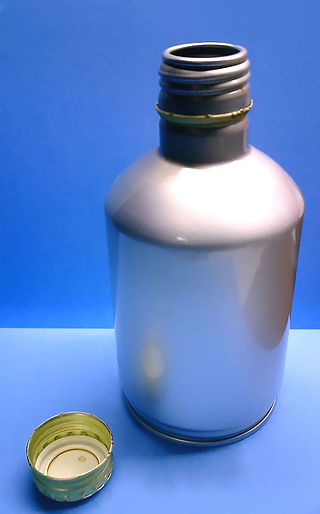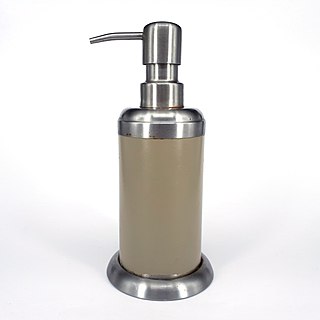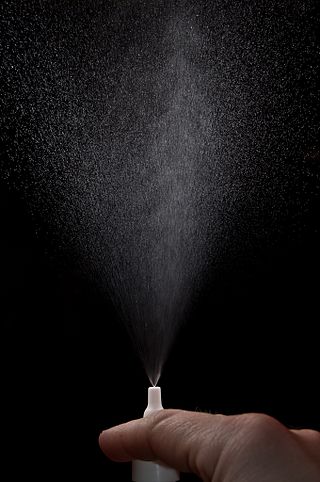
A vacuum flask is an insulating storage vessel that slows the speed at which its contents change in temperature. It greatly lengthens the time over which its contents remain hotter or cooler than the flask's surroundings by trying to be as adiabatic as possible. Invented by Sir James Dewar in 1892, the vacuum flask consists of two flasks, placed one within the other and joined at the neck. The gap between the two flasks is partially evacuated of air, creating a near-vacuum which significantly reduces heat transfer by conduction or convection. When used to hold cold liquids, this also virtually eliminates condensation on the outside of the flask.

A bottle cap or bottle top is a closure for the top opening of a bottle. A cap is sometimes colorfully decorated with the logo of the brand of contents. Plastic caps are used for plastic bottles, while metal with plastic backing is used for glass; plastic caps are commonly made from polyethylene or polypropylene, while metal caps are usually either steel or aluminum. Plastic caps may have a pour spout. Flip-Top caps like Flapper closures provide controlled dispensing of dry products. Caps for plastic bottles are often made of a different type of plastic from the bottle.

Aerosol spray is a type of dispensing system which creates an aerosol mist of liquid particles. It comprises a can or bottle that contains a payload, and a propellant under pressure. When the container's valve is opened, the payload is forced out of a small opening and emerges as an aerosol or mist.

A water dispenser, sometimes referred to as a water cooler, is a machine that dispenses and often also cools or heats up water with a refrigeration unit. It is commonly located near the restroom due to closer access to plumbing. A drain line is also provided from the water cooler into the sewer system.
The term dispenser typically imply a machine or container which is designed to release a specific amount of its content, usually liquids or powders/fine granular materials.

Hair mousse, also referred to as styling foam, is a hairstyling product to protect, control, and style hair. "Mousse" originates from a French term meaning foam. Hair mousse originated in France and was brought to the North American retail market by L'Oreal in the 1980s.

A closure is a device used to close or seal a container such as a bottle, jug, jar, tube, or can. A closure may be a cap, cover, lid, plug, liner, or the like. The part of the container to which the closure is applied is called the finish.

Glass microspheres are microscopic spheres of glass manufactured for a wide variety of uses in research, medicine, consumer goods and various industries. Glass microspheres are usually between 1 and 1000 micrometers in diameter, although the sizes can range from 100 nanometers to 5 millimeters in diameter. Hollow glass microspheres, sometimes termed microballoons or glass bubbles, have diameters ranging from 10 to 300 micrometers.

A soap dispenser is a device that, when manipulated or triggered appropriately, dispenses soap. They can be automatic or manually operated by a handle and are often found in public toilets or private bathrooms

Softsoap is the trade name of Colgate-Palmolive's liquid hand soap and body wash. The company is noted for its soap dispensers' former aquarium theme, where the dispenser would be styled to make the it look like an aquarium with tropical fish printed inside of the plastic.

A spray bottle is a bottle that can squirt, spray or mist fluids.
A high-shear mixer disperses, or transports, one phase or ingredient into a main continuous phase (liquid), with which it would normally be immiscible. A rotor or impeller, together with a stationary component known as a stator, or an array of rotors and stators, is used either in a tank containing the solution to be mixed, or in a pipe through which the solution passes, to create shear. A high-shear mixer can be used to create emulsions, suspensions, lyosols, and granular products. It is used in the adhesives, chemical, cosmetic, food, pharmaceutical, and plastics industries for emulsification, homogenization, particle size reduction, and dispersion.

The toothpaste pump, also known as a toothpaste pump dispenser, is a device used to contain and dispense toothpaste, akin to a tube. An automatic toothpaste dispenser is a self-starting way to dispense toothpaste.
A resin dispensing system is a technical installation to process casting resin for the purpose of filling, sealing, covering or soaking technical parts, especially in the field of electricity and electronics like transformers, LCDs and other devices of various size.

Drum pump, barrel pump, and transfer pump refer to pumps that are used to empty barrels, tanks, IBCs and drums. Many liquids used on manufacturing and processing plants are delivered in 100 or 200 litre barrels and are too heavy to tip to empty the liquids inside. Drum pumps range from simple siphon based devices to sophisticated highly-engineered machinery.

A squeeze bottle is a type of container such as a plastic bottle for dispensing a fluid, that is powered by squeezing the container by exerting pressure with the user's hand. Its fundamental characteristic is that manual pressure applied to a resilient hollow body is harnessed to compress fluid within it and thereby expel the fluid through some form of nozzle.

An automatic soap dispenser is a device that dispenses a controlled amount of soap solution. They are often used in conjunction with automatic faucets in public restrooms. They function to conserve the amount of soap used and stem infectious disease transmission.

A media dispenser or a culture media dispenser is a device for repeatedly delivering small fixed volumes of liquid such as a laboratory growth medium like molten agar or caustic or volatile solvents like toluene into a series of receptacles. It is often important that such dispensers operate without biological or chemical contamination, and so must be internally sealed from the environment and designed for easy cleaning and sterilization before use. At a minimum, a media dispenser consists of some kind of pump connected to a length of discharge tubing or a spout. Dispensers used in laboratories are also frequently connected to microcontrollers to regulate the speed and volume of the medium as it leaves the pump.

A pump dispenser is used on containers of liquids to help dispensing. They might be used on bottles, jars, or tubes. Often the contents are viscous liquids such as creams and lotions. Some are metered to provide uniform usage. Some mix contents from two or more sources prior to dispensing.
















